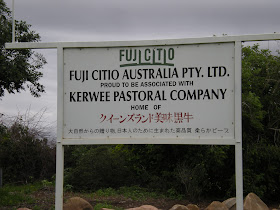I have a few more pictures that I wanted to share with you from the feedyard that I visited in Australia. Be sure to go back and read my observations about Australian feedyards here.
This is the ration that is fed on this feedlot. They use mostly wheat or barley, whatever is cheapest commodity at the time. Some corn is used, but very little, as not much corn is grown in Australia, so that means the cost is high.
I thought this unloading chute was pretty innovative. There is a winch that can raise or lower this ramp depending on the height of the trucks.
As my Aussie friend said their processing facilities aren't very flash (the Aussies use flash a lot), but I think it is quite practical. The facility is equipped with an electronic I.D. scanner. Although, this tag is required for their National ID system, they are also able to use the electronic ID for tracking health treatments, days on feed and other other management data.
The feedyard had a row of signs of all the distributors that they work with. Many are from Japan.






I've just found your blog and I love it! It's so funny to hear about Australia through an American's eyes :)
ReplyDeleteHave you tried the beef? How does it compare?
eatnik I am actually a Canadian living in the States. So that means I have eaten my fair share of beef. I have tried beef in quite a few homes and some restaurants. I would stay I still prefer North American beef. I am not sure if it is because ours is more heavily marbled or has been fed grain for a longer period of time that causes the taste difference. I find your Cryovac aging interesting. Thanks so much for stopping by!
ReplyDeleteI guess I never really knew how similar, and different Australia's feedlots were to ours in North America. They really have to take a lot more precautions due to the high percentage of beef exported vs. consumed locally. 540 days in feed is crazy too!
ReplyDeleteKeep the great blogs coming!